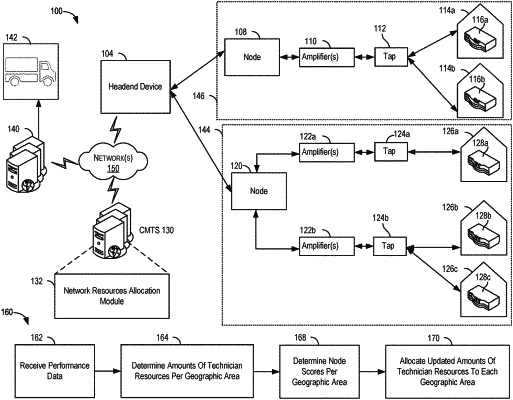| CPC G06Q 10/063116 (2013.01) [G06N 5/04 (2013.01); G06N 20/00 (2019.01); G06Q 10/06393 (2013.01)] | 20 Claims |

|
1. A method comprising:
inputting, by at least one processor of a cable modem termination system (CMTS) device, to a first machine learning model trained to estimate probabilities of nodes experiencing future outage events, performance data associated with a plurality of customer premise devices and a plurality of nodes, wherein the plurality of customer premise devices comprises a first customer premise device and a second customer premise device, the first customer premise device associated with a first node of the plurality of nodes, the second customer premise device associated with a second node of the plurality of nodes;
generating, by the first machine learning model, based on the performance data, a first probability of the first node experiencing a first future outage event;
generating, by the first machine learning model, based on the performance data, a second probability of the second node experiencing a second future outage event;
inputting, to a second machine learning model trained to estimate an optimized amount of technician resources for geographic areas, a first amount of technician resources allocated to a first geographic area comprising the first node;
inputting, to the second machine learning model, a second amount of technician resources allocated to a second geographic area comprising the second node, the first amount of technician resources greater than the second amount of technician resources;
generating, by the second machine learning model, based on the first amount of technician resources, a first optimal amount of technician resources for the first geographic area;
generating, by the second machine learning model, based on the second amount of technician resources, a second optimal amount of technician resources for the second geographic area;
determining, based on the performance data, the first probability, the second probability, the first optimal amount of technician resources, and the second optimal amount of technician resources input to a third machine learning model trained using node performance data and technician resource data to predict demand for technician resources, a first score associated with the first node, the first score indicative of a first predicted demand for technician resources;
determining, based on the performance data, the first probability, the second probability, the first optimal amount of technician resources, and the second optimal amount of technician resources input to the third machine learning model, a second score associated with the second node, the second score indicative of a second predicted demand for technician resources;
re-training, based on feedback based on comparisons of the first predicted demand and the second predicted demand to actual demand for technician resources at the first node and the second node, the third machine learning model to generate a third score indicative of a third predicted demand for technician resources at the first node and a fourth score indicative of a fourth predicted demand for technician resources at the second node; and
causing, based on the third score and the fourth score, a third amount of technician resources to be allocated to the first geographic area and a fourth amount of technician resources to be allocated to the second geographic area.
|